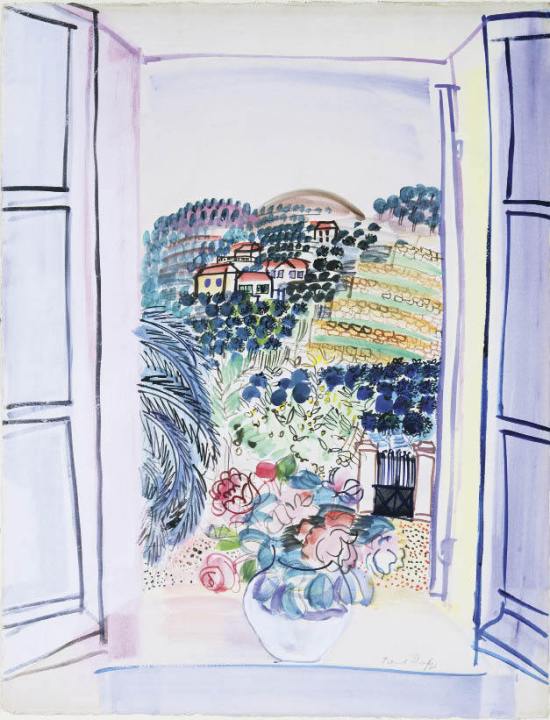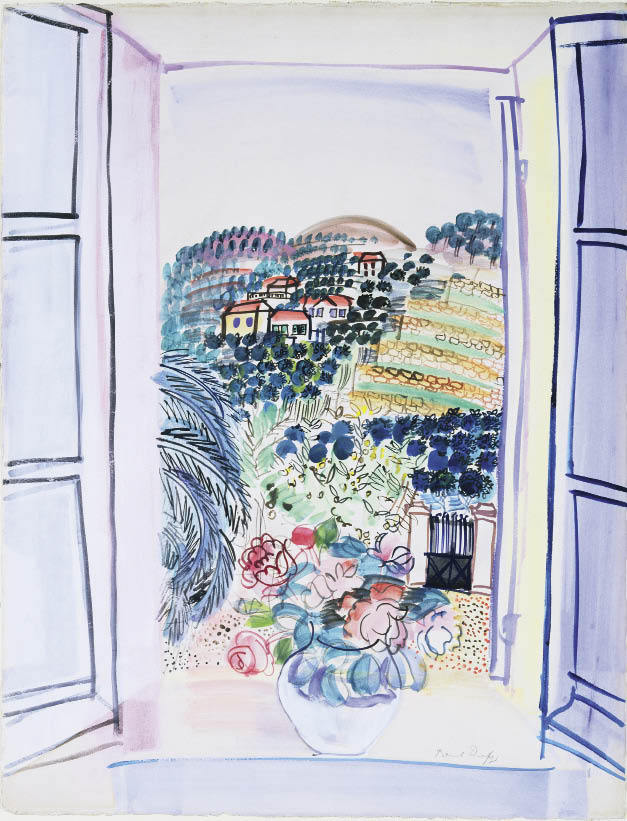Without from Within
Djanogly Art Gallery, Nottingham, until 3 May
In 1935 Magritte painted a picture called ‘La Condition Humaine’ showing a mountain landscape seen from inside a cave. In the mouth of the cave an easel with a see-through canvas perfectly frames the view of a distant castle, while a fire burning inside reminds us of Plato’s famous allegory of human knowledge, comparing us to prisoners in a cave whose only perception of reality is based on shadows thrown by firelight on the walls. Painting, Magritte implies, is similarly partial (although presumably an advance on shadows for a cave-dweller).
Magritte’s picture hangs at the centre of Without from Within, a new exhibition at Nottingham University’s Djanogly Art Gallery tracing 100 years of views from indoors out. Starting with Spencer Gore’s ‘View from a Window’ (1909) and ending with George Shaw’s ‘Not Seeing Blossom’ (2010), it’s a saunter down a magical corridor whose 40 windows all open on to different prospects. They include Mediterranean hillsides (Raoul Dufy, 1926), Cornish beaches (Christopher Wood, 1930), snow-covered Buckinghamshire fields (John Nash, 1928), Sussex gardens (Charles Ginner, 1930–40) and Californian seascapes (David Hockney, 1968). Nothing unexpected, in other words, apart from the seaplanes bobbing outside Eric Ravilious’s ‘R.N.A.S. Sick Bay Dundee’ (1941).
The picture structures, too, are predictable. There’s not much room for variation with views through windows, other than shifting the angle of approach or tweaking the curtains, yet the subject has an enduring appeal to artists — and not only because it doesn’t rain indoors. For the philosophically minded, the window is a metaphor for painting itself; for the technically minded, glazing bars against the light represent the ultimate tonal challenge.
Of the 34 artists represented here, only Spencer Gore passes this test with flying colours. Winifred Nicholson sensibly avoids it in ‘Glimpse Upon Waking’ (1976) by drawing her curtains into a titillating ‘V’ at the bottom to frame a triangle of milky Mediterranean sunrise. Duncan Grant takes a leaf — and several rolls of floral wallpaper — out of Matisse’s book and gives us a textbook exercise in how to lead the eye from indoors out through his ‘Window, South of France’ (1928), while Roger Fry, whose ‘The Window’ (1918) faces a blank garden wall, gives us a demonstration of how not to. Vanessa Bell teaches both men an imaginative lesson with her oblique ‘View into a Garden’ (1926), allowing us to deduce what’s around the corner from a patch of sunlight striking the top of a door.
Things start getting trickier with Paul Nash. In ‘Harbour and Room’ (1932–36) a wall is slid aside to admit the sea, while in ‘Dead Spring’ (1929) a pot plant stands in a casement window apparently constructed from picture frames. In the 1960s, Patrick Caulfield pushed this ambiguity further in ‘Santa Margherita Ligure’ (1964), a Matisse-meets-Lichtenstein pastiche of a Mediterranean postcard view seen through a spatially impossible window. But the current generation is playing it straighter. Paul Winstanley’s Hammershoi-esque ‘Villa’ (2009) is admittedly more concerned with the fall of light and shadow through plate-glass windows than the view out, but George Shaw’s focus is more traditional. His intimate little painting of the view from his parents’ home on a Coventry estate is a lament for a lost flowering tree of his youth, replaced in ‘Not Seeing Blossom’ (2010) with a telegraph pole. Marcus Harvey’s ‘The Führer’s Cake’ (2009) is more obviously ironic: a picture-window view of snow-capped Bavarian peaks with a slice of white-iced cake on the sill.
Without from Within opens a window on an intriguing subject that still, surprisingly, has plenty of mileage in it. It’s the sort of intelligently curated regional exhibition that too rarely attracts national interest, although on the afternoon I visited a busload of curators were about to descend from the Whitechapel. How so? They were in town to see Star City: The Future under Communism (until 18 April) at the brand-new Nottingham Contemporary.
If you’re nostalgic for the space race, this exhibition — with contributions from Jane and Louise Wilson, Ilya Kabakov and Aleksandra Mir — is worth a visit, and the gallery café does proper tea and cake. If you’ve got all day, there’s also Now for Tomorrow: 100 years of collecting at Nottingham Castle Museum and The Meaning of Style — 40 years of African Caribbean male fashion — at the recently opened multi-ethnic New Art Exchange. Nottingham now has more galleries than Robin Hood visitor attractions and lace souvenir shops put together. Just don’t make my mistake and try to take a tram from the station to the Djanogly or you’ll end up at the city’s fifth art gallery, the Bonington at Nottingham Trent University, currently showing an exhibition called Fictions. Be warned: the Bonington’s line in avant-garde programming makes Nottingham Contemporary look passé.







Comments